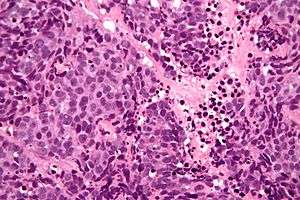Sinonasal undifferentiated carcinoma
Sinonasal undifferentiated carcinoma (SNUC) is a rare aggressive type of cancer that arises from epithelium or lining of the nose or sinuses.[1]
| Sinonasal undifferentiated carcinoma | |
|---|---|
 | |
| Micrograph of a SNUC. H&E stain. | |
| Specialty | ENT surgery |
Signs and symptoms
In most cases, symptoms present themselves at an advanced stage of disease. They can include but are not limited to: Nosebleed Nasal obstruction Proptosis (displacement of the eye) Vision changes Headache
Pathology
The underlying mechanism is unknown, however, Gelbard et al. studied 12 oncogenes or known tumor suppressor gene “hotspots” where mutations in these regions are known to cause other types of neurocarcinomas. They also studied Single nucleotide polymorphisms (SNPs) located in Vascular endothelial growth factor (VEGF) in order to find sites for finely targeted therapeutics.
Spectroscopy-based research done in this study identified 95 common mutations within the 12 hotspots. Of the 95 SNPs none presented a genotype that was an activating mutation.
 Low mag.
Low mag. High mag.
High mag.
Diagnosis
Sinonasal Undifferentiated Carcinoma (SNUC) is a rare and aggressive type of cancer originating in the epithelial layer of the nasal cavity or paranasal sinuses. It was first diagnosed in 1987. The aggressive nature of the cancer coupled with the advanced stage of disease upon presentation lead to a poor survival rate. Although the molecular nature of the mutation that causes SNUC is still poorly understood clinical treatment has shown that multimodality treatment has been the most successful option.
Treatment
All published findings on SNUC suggest that therapy that gives more than one kind of treatment (multimodality treatment) give SNUC patients the best possible chance for survival. Varying combinations of and length between surgery, radiation, and chemotherapy have been tested. Findings from Mendenhall et al. have suggest that surgery plus radiotherapy and concominant chemotherapy is most efficient rather thain radiotherapy combined with induced or maintenance chemotherapy.
Prognosis
In a Meta-analysis study to conglomerate findings regarding 28 published papers including 158 patients presenting SNUC following up with patients for an average of 14 months showed that at the time of last follow up 25% of patients were alive with no evidence of the disease, 22.4% were alive with presence of the disease, and 52.6% were deceased due to the disease.
See also
References
- "Sinonasal undifferentiated carcinoma | Genetic and Rare Diseases Information Center (GARD) – an NCATS Program". rarediseases.info.nih.gov. Retrieved 18 November 2019.